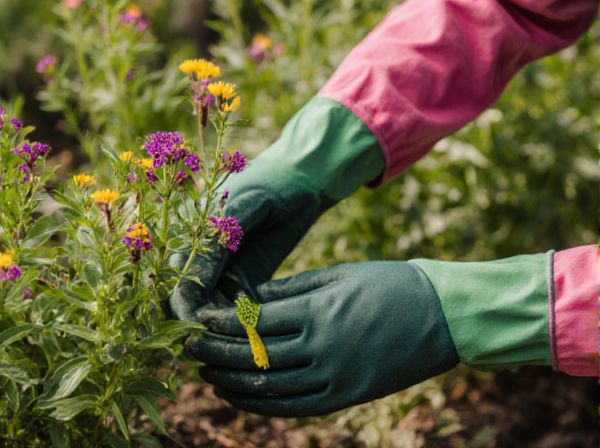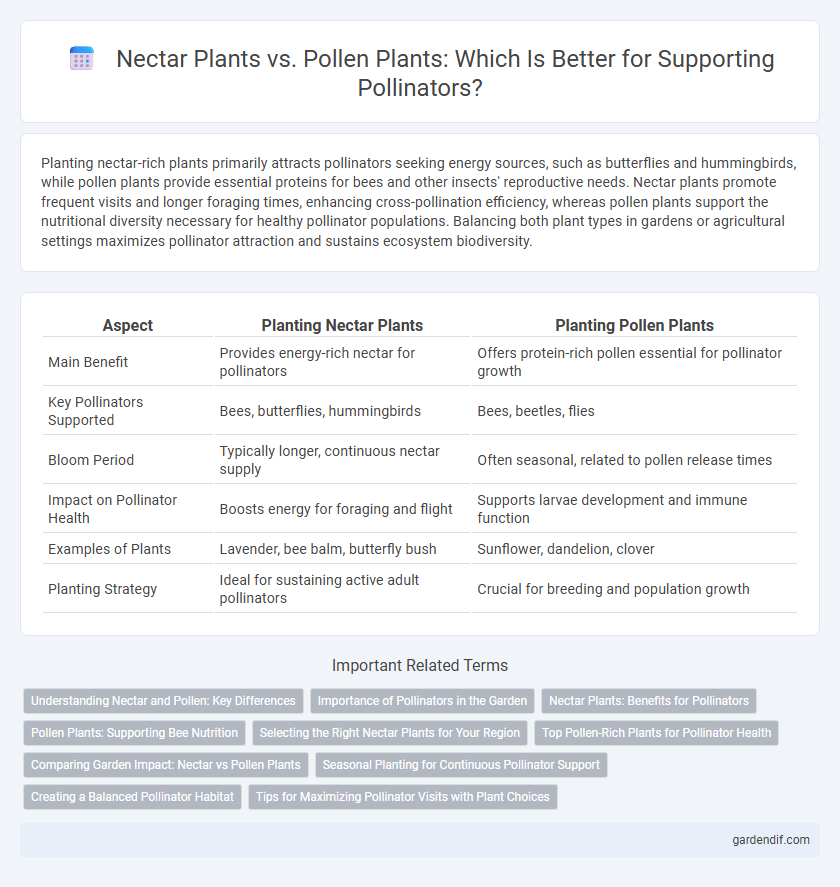
Planting nectar plants vs Planting pollen plants Illustration
Planting nectar-rich plants primarily attracts pollinators seeking energy sources, such as butterflies and hummingbirds, while pollen plants provide essential proteins for bees and other insects' reproductive needs. Nectar plants promote frequent visits and longer foraging times, enhancing cross-pollination efficiency, whereas pollen plants support the nutritional diversity necessary for healthy pollinator populations. Balancing both plant types in gardens or agricultural settings maximizes pollinator attraction and sustains ecosystem biodiversity.
Table of Comparison
| Aspect | Planting Nectar Plants | Planting Pollen Plants |
|---|---|---|
| Main Benefit | Provides energy-rich nectar for pollinators | Offers protein-rich pollen essential for pollinator growth |
| Key Pollinators Supported | Bees, butterflies, hummingbirds | Bees, beetles, flies |
| Bloom Period | Typically longer, continuous nectar supply | Often seasonal, related to pollen release times |
| Impact on Pollinator Health | Boosts energy for foraging and flight | Supports larvae development and immune function |
| Examples of Plants | Lavender, bee balm, butterfly bush | Sunflower, dandelion, clover |
| Planting Strategy | Ideal for sustaining active adult pollinators | Crucial for breeding and population growth |
Understanding Nectar and Pollen: Key Differences
Nectar plants primarily produce sugary fluids that attract pollinators for energy, while pollen plants generate protein-rich pollen essential for pollinator nutrition and reproduction. Recognizing the distinct roles of nectar and pollen helps gardeners select the right mix of plants to support diverse pollinator species throughout their lifecycle. This balance enhances pollinator health and promotes ecosystem stability by providing both immediate energy and vital proteins.
Importance of Pollinators in the Garden
Planting nectar-rich plants attracts pollinators such as bees, butterflies, and hummingbirds by providing essential energy sources that support their feeding and movement. Pollen-producing plants are vital as they supply proteins necessary for the growth and reproduction of pollinator populations. Supporting a diverse mix of nectar and pollen plants enhances garden biodiversity, improves pollination efficiency, and boosts overall plant health and fruit yield.
Nectar Plants: Benefits for Pollinators
Nectar plants provide essential energy-rich sugars that fuel pollinators' daily activities, supporting their survival and reproduction. By planting a diverse range of nectar-rich flowers, pollinators like bees, butterflies, and hummingbirds gain continuous access to vital food sources throughout the growing season. Nectar plants also enhance ecosystem health by promoting pollinator diversity, which in turn improves plant pollination and biodiversity.
Pollen Plants: Supporting Bee Nutrition
Pollen plants play a crucial role in supporting bee nutrition by providing essential proteins and lipids necessary for brood development and overall colony health. Unlike nectar plants, which primarily offer energy-rich sugars, pollen plants supply the macronutrients that fuel bee growth and immune function. Integrating a diverse range of pollen-producing flora ensures sustained bee populations and biodiversity within ecosystems.
Selecting the Right Nectar Plants for Your Region
Choosing the right nectar plants for your region is essential to support local pollinators and enhance biodiversity. Native nectar-rich flowers such as milkweed in North America or lavender in Mediterranean climates provide optimal food sources for butterflies, bees, and hummingbirds. Selecting plants adapted to the local soil, climate, and pollinator species increases bloom duration and ensures sustainable nectar availability throughout the growing season.
Top Pollen-Rich Plants for Pollinator Health
Top pollen-rich plants such as sunflowers (Helianthus annuus), red clover (Trifolium pratense), and goldenrod (Solidago spp.) provide essential nutrition for pollinators, supporting their protein needs critical for growth and reproduction. Unlike nectar plants that supply sugars for energy, pollen plants offer vital amino acids that enhance immune function and colony strength in bees and other pollinators. Incorporating a diverse range of pollen-producing species ensures sustained pollinator health and biodiversity throughout the growing season.
Comparing Garden Impact: Nectar vs Pollen Plants
Planting nectar plants attracts a diverse array of pollinators like butterflies and hummingbirds by providing essential energy-rich sugars crucial for their survival and activity, thereby enhancing pollination efficiency. In contrast, pollen plants primarily benefit bee populations by supplying protein-rich pollen necessary for brood development and colony growth, directly impacting pollinator health and reproduction. Gardens incorporating both nectar and pollen plants create a balanced ecosystem that supports a wider range of pollinator species and promotes biodiversity.
Seasonal Planting for Continuous Pollinator Support
Planting nectar-rich flowers like milkweed, coneflowers, and phlox ensures a consistent energy source for pollinators throughout the growing season. Incorporating pollen-producing plants such as sunflowers, goldenrod, and asters provides essential protein needed for bee brood development and overall colony health. Strategically selecting species with staggered bloom times from spring through fall guarantees continuous pollinator support and biodiversity in garden ecosystems.
Creating a Balanced Pollinator Habitat
Planting nectar plants such as lavender, butterfly bush, and bee balm provides essential energy resources for pollinators, while incorporating pollen-rich species like sunflowers, goldenrod, and asters ensures protein supply crucial for pollinator development. A balanced pollinator habitat combines diverse flowering plants with staggered bloom times to support various pollinator species throughout the growing season. This integrated approach enhances pollinator health, biodiversity, and the overall resilience of the ecosystem.
Tips for Maximizing Pollinator Visits with Plant Choices
Choosing a diverse range of nectar-rich plants like lavender, bee balm, and milkweed attracts a wide variety of pollinators by providing essential energy sources. Incorporating pollen-producing plants such as sunflowers, goldenrod, and asters ensures pollinators receive vital proteins required for reproduction and colony health. Planting species with staggered bloom times and clustered arrangements enhances accessibility and supports continuous pollinator activity throughout the growing season.
Planting nectar plants vs Planting pollen plants Infographic

 gardendif.com
gardendif.com